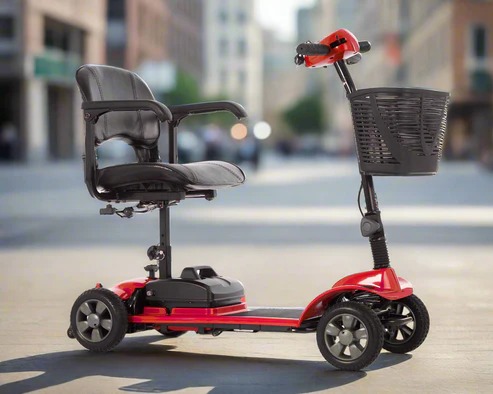
The 5 Biggest Hidden Costs That Can Come With Owning A Mobility Scooter
For the majority of people who find themselves in the position of shopping for mobility scooters, the prospect of recapturing some independence can often cloud their ability to look past the rewards and understand the true scale of their commitment. There’s a certain level of excitement that comes with the idea of owning a mobility scooter. The freedom to move around on your own terms, visit friends, pop to the shops, or simply enjoy the outdoors without relying on others. It’s a life-changer.
But in that excitement, it’s easy to overlook something important; the ongoing running costs! The reality of owning a mobility scooter, unfortunately is, much like a car; a mobility scooter isn’t just a one-time purchase. Batteries degrade, tires wear down, and unexpected repairs can creep up at the worst times. Then there are the optional, but often necessary, extras—things like insurance, servicing, and comfort upgrades that make all the difference in daily use.
All of these compounding factors are why, in this article, we’re breaking down the hidden costs of owning a mobility scooter. Not to put you off (far from it, we don’t want to do that at all) but so you can plan ahead and be aware of all of the expenses which can, all too suddenly, become an issue without having such a plan in place.
1) Battery Replacements
Sadly, there's a common misconception that the battery on a brand-new mobility scooter will last years. But the truth? Most mobility scooter batteries need replacing every 1 to 3 years, and when that time comes, the cost can range from a manageable £50 to a more eye-watering £300, depending on the model and type.
As with those on an electric car (or even those in your TV remote) the reason is simple; batteries degrade over time! A mobility scooter’s battery gradually loses efficiency. Frequent charging cycles, not taking good enough care of a scooter, and even the kind of seasonal temperature changes they’re exposed to can all shorten their lifespan.
So, what can you do? Well obviously there’s no way to make a battery last forever, but proper care can significantly extend its lifespan. Avoid fully draining the battery before charging, keep it stored in moderate temperatures, and use a high-quality charger that prevents overcharging.
2) Maintenance & Repairs
Much as is the case with having to replace the batteries, another hard reality of owning a mobility scooter is that there are costs that come with the inevitable wear and tear over time. And, If you’re not budgeting for it, repair costs can come as an unpleasant surprise.
Tires wear down. Brakes need adjusting. Motors and suspension don’t last forever. And while a general service might only set you back £50–£100, unexpected breakdowns can cost significantly more. Tire replacements? £20–£50 each. Brake servicing? £50–£150. Let the problems build up, and suddenly, you’re looking at a much bigger bill.
Much of this can be avoided (or at the least mitigated against) if you look after your scooter and consider a servicing plan with whoever it is you buy it from.
3) Insurance
A mobility scooter is not quite a car, so insurance isn’t actually legally required, but mobility scooter insurance is one of those things you don’t realise you need—until you do. Theft, accidental damage, third-party liability… Without cover, any of these can leave you seriously out of pocket.
Policies typically range from £40 to £100 per year, which might seem like an unnecessary extra but once you think about how much the cost of replacing a stolen scooter or covering damage after an accident would be, it doesn’t seem so steep after all.
Sure, some people take the risk. But if your scooter is essential for daily life, skipping insurance is a gamble that might cost far more than the yearly premium.
4) Accessories & Upgrades
A lot of different mobility scooter models are made to be functional, which doesn’t always mean they’ll be comfortable. Many owners quickly realise that the stock setup is basic at best, leading to a string of small (but costly) upgrades to make everyday use more practical.
A weather cover to shield against rain? £30–£100. A padded seat or backrest to make long rides more bearable? £50–£200. Extra storage baskets or bags? £20–£80. None of these are technically essential—but they can make a huge difference to usability.
The reality is, while a scooter might seem like a one-and-done purchase, the upgrades needed to make it truly fit your lifestyle often come at an extra price.
5) Charging Costs
With the typical yearly bill for electricity in UK households set to be around £1800 in 2025, the thought of adding the costs of mobility scooter charging onto this is a somewhat fear-inducing prospect.
While the exact cost depends on your energy provider and battery size, estimates suggest most owners spend £15–£40 per year just on keeping their scooter powered. It’s not a huge expense, but it’s still an ongoing cost that never goes away. And for those using rapid chargers or charging multiple times a day? The number climbs.
Final Thoughts
Owning a mobility scooter is about freedom, but that freedom comes with a price—one that’s often underestimated. The upfront cost is only part of the equation; from battery replacements and maintenance to insurance, accessories, and charging costs, the real expense of ownership extends far beyond the initial purchase.
That doesn’t mean a scooter isn’t worth it—far from it. But knowing what to expect allows you to budget properly, avoid nasty surprises, and make smarter decisions about which model and features best suit your needs.
Because at the end of the day, a mobility scooter should make life easier, not create financial headaches.

Comments (0)